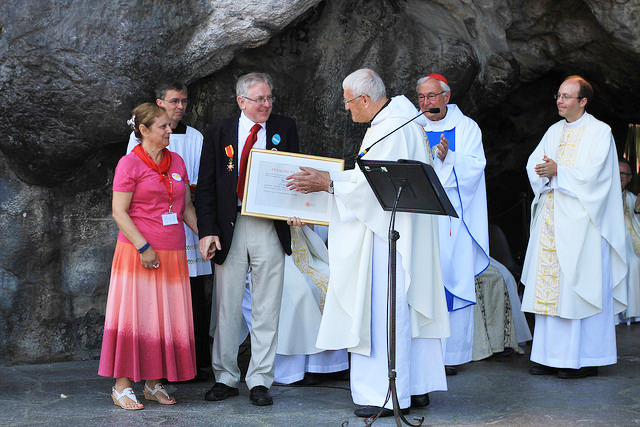‘Surprised, overwhelmed, very emotional and a great honour’ is how Bernard Lavery described the feeling when he was made a Knight of St Gregory. Bernard has been successfully coordinating logistics for the Lourdes pilgrims, abled and less abled, from the various parishes of the diocese every summer, with an enterprising core team of 40 support and 10 executive members in addition to the large groups of Redcaps and student volunteers that assist.
It all began when his mother visited Lourdes for the very first time in 1952. On her return, sharing her experience fascinated Bernard. Nineteen years later, on his first visit to Lourdes with the Diocese of Hexham and Newcastle, he says: ‘It didn’t fail to disappoint, it was everything I imagined.’ Drawing inspiration from his profession of freight forwarding, he humorously comments: ‘By profession I move boxes around the world, and in Lourdes we help move people from around the world.’
It was in Archbishop’s House where the idea for the pilgrimage was first discussed, with Cardinal Basil Hume leading the pilgrimage and Fr Vladimir Felzmann, the then Pilgrimage Director. What has kept him going in the last 30 years is the fact that he enjoys what he does. His precious moment at the Grotto came when Bernard helped carry the ombrellino during the Blessed Sacrament Procession assisting Cardinal Hume to the Blessed Sacrament chapel; he experienced an intimate moment with the divine as Benediction was given to the sick.
Bernard joined the Redcaps as a Team Leader working extensively on the ceremonies team and then moved to being the Youth Director for following six years before taking over as President of the pilgrimage team. The work involved ranges from chairing the executive committee of the St Frai team (St Frai is a medical home in Lourdes for the sick, elderly and disabled pilgrims with medical facilities and medical staff on duty 24/7), attending meetings with Pilgrimage Directors from the all over the UK to working with the domain of planification of the Lourdes Shrine to make arrangements for pilgrims.
Amidst all this, Bernard credits his wife and immediate family, who form the backbone of his good work. His wife, Pirlanta, developed the idea of the Reds, the same year when Bernard took over as Youth Director (Reds are a group of 12 to 14 year olds, who follow a programme of spiritual teaching and assist in the St Frai during the week). A lot of thought and care is put in assisting pilgrims with medical needs, from identifying resources required like pressure mattresses, dialysis unit etc, to trying to source some of these locally, especially those that pose a logistic challenge. It’s a whole year’s planning and prepping with the exception of December/January. His support team works very hard to make all of this possible. There are years when the volunteering numbers of medical staff, school students and helpers are down but eventually it all comes together beautifully into what we know as the yearly diocesan pilgrimage.
The schools that join the pilgrimage carry out fundraising activities all throughout the year: cake sales, raffle sales etc. There is a known trend of ‘reverse evangelization’ that takes place at the end of the pilgrimage with school students enthusiastically returning home with the zeal of Our Lady’s love in their hearts that draws their parents to the Grotto the next year.
Bernard was made a Knight of St Gregory at the closing Mass at the Grotto on the final day of the pilgrimage; there could not have been a better location. With the Mass being televised live on Lourdes Sanctuaire TV, his sister co-incidentally happened to be watching the Mass from her home in Yorkshire and was as surprised and ecstatic as was he on receiving it.
Bernard speaks of the challenges that lie ahead for the pilgrimage in the next 30 years, which are, ‘how to keep the pilgrims engaged with Lourdes not as a place of historical interest, rather for its spiritual significance; and motivating pilgrims to travel as a diocesan family than independently.’ When Bernard started off, he did not aspire for any award, rather doing what made him happy.
His experience with Our Lady at the Grotto worked as motivation to bring more people to Lourdes and this effort was recognized. He adds: ‘My heartfelt thanks for all the congratulatory cards and letters received. It has been a fulfilling experience.’
The Order of St Gregory the Great is one of the five Orders of Knighthood of the Holy See. The honour is bestowed upon men and women in recognition of their personal service to the Holy See and the Roman Catholic Church.




